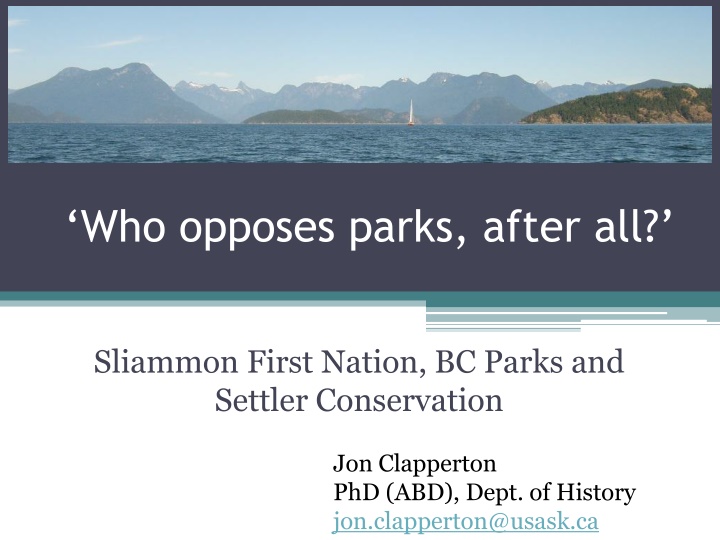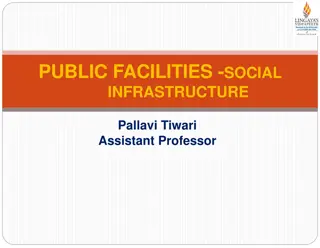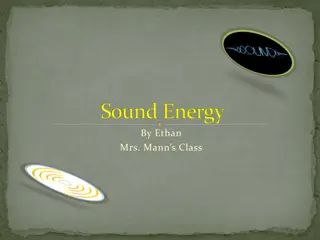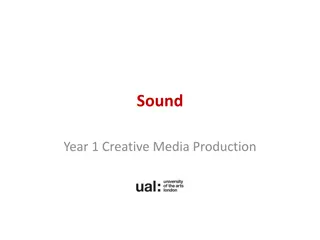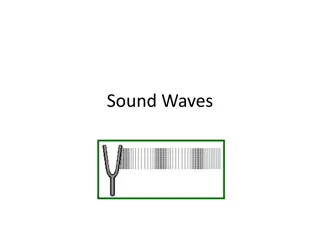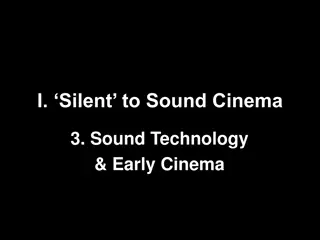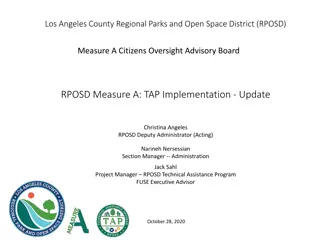Contesting Boundaries: Sliammon First Nation's Struggle with Desolation Sound Parks
Sliammon First Nation, BC Parks, and settler conservationist Jon Clapperton explore the complex power dynamics and competing narratives surrounding Desolation Sound Parks. The area's history reveals a tumultuous interplay between indigenous perceptions of the environment, outsider viewpoints, and struggles for control over land and discourse. Through maps and historical context, the contested nature of park boundaries and the impact of colonial legacies are laid bare.
Download Presentation

Please find below an Image/Link to download the presentation.
The content on the website is provided AS IS for your information and personal use only. It may not be sold, licensed, or shared on other websites without obtaining consent from the author.If you encounter any issues during the download, it is possible that the publisher has removed the file from their server.
You are allowed to download the files provided on this website for personal or commercial use, subject to the condition that they are used lawfully. All files are the property of their respective owners.
The content on the website is provided AS IS for your information and personal use only. It may not be sold, licensed, or shared on other websites without obtaining consent from the author.
E N D
Presentation Transcript
Who opposes parks, after all? Sliammon First Nation, BC Parks and Settler Conservation Jon Clapperton PhD (ABD), Dept. of History jon.clapperton@usask.ca
2 Making Desolation Sound Parks as windows into the entwined histories of Aboriginal peoples, environmentalism, and the (re)making of place. Viewscapes of Desolation Sound represent(ed) a microcosm of power relations in flux between dominant, outsider and subaltern, indigenous perceptions of the environment. Specifically, Natives and newcomers were (and remain) involved in a competition over who controlled a master discourse of what made a desirable desolation , and by extension where, how, and even if different peoples fit into this space. Maps from: http://www.env.gov.bc.ca/bcparks/explore/regional_maps/
3 Situating Sliammon (Tla Amin) First Nation Traditional Territory Map (top left) and Sliammon I.R. 1 (above) from: www.sliammontreaty.com Map (left) from: http://www.gov.bc.ca/arr/firstnation/maps/map_2.htm
4 Desolate (v): To Deprive of Inhabitants For the Sliammon, Desolation Sound Marine Park was merely the redrawing of boundaries on an already- colonized space; it was part of a continuum of the land- and sea-scape being made a desolation by outsiders. Images of Powell River Mill construction from: www.powellrivermuseum.ca/LeMayLane
5 A Desolate Paradise In the 1920s local and visiting yachters and outdoors enthusiasts began promoting Desolation Sound as an uninhabited, wilderness paradise, despite the obvious signs of its past and ongoing human influence, both by Natives and newcomers. While Desolation Sound and area has been depicted as largely untouched by human hands, physical traces of extensive environmental alteration abounds. Photographs courtesy Georgia Combes
6 Desolation: To Cause Extensive Destruction or Ruin; To Make Joyless and Comfortless. Often the most violence done to the colonized, subaltern Other comes from means less obvious and more insidious than outright physical force; in the process of Othering, the experience of the subaltern becomes made irrelevant because it is outside the system of normality and convention as determined by the dominant structure. BC Parks established a frame wherein only certain activities could be considered acceptable and within which only certain aspects of the park environment were considered worthy of protection. Photographs courtesy Georgia Combes
7 The Politics of Wilderness Exclusion Both the general public and the provincial government have used a discourse of wilderness to challenge the Slimmon s use of the area, for both traditional resource extraction such as bark stripping, or economic ventures such as oyster farming. Photos by Jon Clapperton
8 The Subaltern Speaks in Desolation Sound The ongoing treaty process has provided a forum within which First Nations could voice their perspectives on parks and protected areas, as well as revealed the broader public s fear of Aboriginal control over these spaces. The Sliammon have also taken the opportunity manage Okeover Arm Provincial Park. Now in the final stage of treaty negotiations, Sliammon First Nation s current agreement in principle, if ratified, will give them the option to purchase crown land adjacent to Desolation Sound Marine Park. It also includes a guarantee (at least in theory) for a joint stewardship program integrating the Sliammon s cultural values into BC Park s management of parks within the Sliammon s traditional territory.
9 Individual Agency and Cross Cultural Alliance Sliammon elder Norman Gallagher and former BC Parks Ranger Georgia Combes, among some other key individuals, forced the issue of Aboriginal rights and interests in managing parks, including both environmental and archaeological destruction. Unfortunately, a sequence of unforeseeable events led to this cross-cultural integration process stagnating, if not halting entirely. From: Joanne Hammond, South Texada Island Provincial Park Archaeological Study 2007- 360 Final Report (Vancouver: Pacific Heritage Research, 2008), 21.
